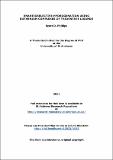Files in this item
Enantioselective hydrogenation using ruthenium complexes of tridentate ligands
Item metadata
| dc.contributor.advisor | Clarke, Matt | |
| dc.contributor.author | Phillips, Scott D. | |
| dc.coverage.spatial | 200 | en_US |
| dc.date.accessioned | 2011-07-14T12:39:16Z | |
| dc.date.available | 2011-07-14T12:39:16Z | |
| dc.date.issued | 2011-06-22 | |
| dc.identifier | uk.bl.ethos.552579 | |
| dc.identifier.uri | https://hdl.handle.net/10023/1915 | |
| dc.description.abstract | This thesis describes the development of the [RuCl₂(P^N^N)L] catalytic system for asymmetric hydrogenation. It has been demonstrated that the current system is efficient in preparing a range of bulky chiral alcohols in good enantioselectivity, many of which are likely to be inaccessible using the more classic [RuCl₂(P^P)N^N)] system developed by Noyori and coworkers. It has been shown that the current system is tolerant of a range of substrate electronic effects as well as the presence of heteroaromatic functionality, thus showing its applicability in synthesis. This has been extended to prepare a number of bulky derivatives of synthetically important molecules. The demonstration of this is significant as in drug design, for example, studies that aim to extend lipophilicity or steric bulk make the ability to prepare alcohols across the full range of steric properties important. We have shown that chiral alcohols with adjacent gem-dimethyl groups can be prepared in high enantioselectivity and their conversion into other valuable molecules, such as chiral lactones has been demonstrated. Detailed mechanistic studies have been undertaken for the present system in order to aid rational design of new, more active and selective catalysts. A number of achiral variants of the original system have been prepared and the key features of ligand structure for efficient catalysis have been identified. This was accomplished by rigorous kinetic analysis of each complex, using specialist gas-uptake monitoring equipment. The key features of catalyst structure and optimal reaction conditions for efficient asymmetric hydrogenation have been identified. Our greater understanding of the present system allowed us to rationally design new catalysts of for enantioselective hydrogenation. Our aim was to be able to tune the catalyst structure to carry out hydrogenation of a greater variety of ketone substrate with high activity and selectivity. We have successfully prepared second generation catalysts that show enhanced enantioselectivity for a variety of substrates, many of which were problematic with the Noyori system. | en_US |
| dc.language.iso | en | en_US |
| dc.publisher | University of St Andrews | |
| dc.subject | Enantioselective hydrogenation | en_US |
| dc.subject | Catalysis | en_US |
| dc.subject | Ketone hydrogenation | en_US |
| dc.subject | Phosphine synthesis | en_US |
| dc.subject | Tridentate ligands | en_US |
| dc.subject | Ruthenium complexes | en_US |
| dc.subject.lcc | QD281.H8P5 | |
| dc.subject.lcsh | Hydrogenation | en_US |
| dc.subject.lcsh | Enantioselective catalysis | en_US |
| dc.subject.lcsh | Platinum group catalysts | en_US |
| dc.subject.lcsh | Ruthenium compounds | en_US |
| dc.subject.lcsh | Asymmetry (Chemistry) | en_US |
| dc.title | Enantioselective hydrogenation using ruthenium complexes of tridentate ligands | en_US |
| dc.type | Thesis | en_US |
| dc.type.qualificationlevel | Doctoral | en_US |
| dc.type.qualificationname | PhD Doctor of Philosophy | en_US |
| dc.publisher.institution | The University of St Andrews | en_US |
This item appears in the following Collection(s)
Items in the St Andrews Research Repository are protected by copyright, with all rights reserved, unless otherwise indicated.

